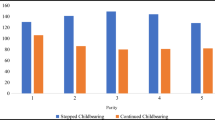Abstract
“The timing of first birth” is taken to mean the distribution of first births among a cohort of women. (1) How large is the final proportion of women who have at least one birth and (2) what is the distribution of women by age at first birth?
“The percentage of non-fecund women” and “the age-specific risk for a fecund woman of remaining childless” are useful parameters in predicting final childlessness. These parameters are estimated. It is found that the risk of a fecund woman remaining childless is substantial even at the most common childbearing age. The effect of postponement of births on final childlessness is demonstrated and quantified. It is shown that the higher level of childlessness among women with long education can be explained by postponement of childbearing. The expression “later means fewer” is also true for first births.
A method of predicting first birth rates, presented earlier by the author, is discussed and shown to give a good fit to Swedish data.
Résumé
On entend ici sous le terme de «calendrier de la première naissance», la répartition au cours du temps des premières naissances d'une cohorte de femmes, qui permet de répondre aux questions suivantes: (1) quelle est la proportion finale des femmes qui ont au moins un enfant, et (2) quelle est leur répartition par âge à cette première naissances?
La «proportion de femmes non fécondes» et la «probabilité qu'une femme féconde d'âge donné n'ait pas d'enfant» sont des caractéristiques utiles pour prévoir l'infécondité définitive de ces cohortes. L'estimation de ces paramètres nous montre un risque important pour une femme de ne pas avoir d'enfant, même aux âges de fécondité maximale. L'effet de l'ajournement des naissances sur l'infécondité définitive est quantifié et montre qu'il explique l'infécondité plus élevée des femmes qui ont fait de longues études. L'expression «avoir des enfants plus tard entraîne moins d'enfants» est donc également vérifiée pour les premières naissances.
On discute une méthode de prévision des taux de fécondité de rang un, déjà présentée par ailleurs, et l'on montre qu'elle s'ajuste bien aux données suédoises.
Similar content being viewed by others
References
Bloom, D. E., 1982. Age patterns of women of first birth, Genus, 38: 101–128.
Coale, A. J., 1971. Age patterns of marriage. Population Studies, Vol. 25, No. 1, 193–214.
Coale, A. J., 1977. The development of new models of nuptiality and fertility, Population, numéro spécial, 1977: 131–154.
Hoem, J. M., 1978. Demographic incidence rates. Theoretical population biology, V. 14(3): 329–327.
Johansson, L. and Finnäs, Fjalar, 1983. Fertility of Swedish women born 1927–1960 (Urval, Statistics Sweden).
Martinelle, S., 1989. A cohort model for analyzing and projecting fertility by birth order. (IUSSP New Delhi), Vol. 1, 315–329.
Martinelle, S., 1990. The timing of first birth. Analysis and prediction of Swedish birth rates. (Bakgrundsmaterial 1990:1, Population Research Office, Statistics Sweden).
Martinelle, S. et al., 1992. Fertility in a life-perspective (Demografiska rapporter 1992:1, Statistics Sweden).
Qvist, J., 1987. Kohortfruktsamhet 1945–1985. Demografiska rapporter 1987:3, Statistics Sweden.
Author information
Authors and Affiliations
Rights and permissions
About this article
Cite this article
Martinelle, S. The timing of first birth. Eur J Population 9, 265–286 (1993). https://doi.org/10.1007/BF01266020
Received:
Accepted:
Issue Date:
DOI: https://doi.org/10.1007/BF01266020




